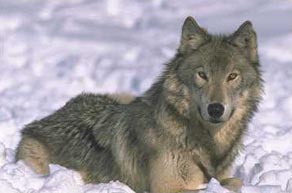|
DIMENSIONS: ecosystem |
Policy
Legal History of the Yellowstone Wolf Reintroduction Naturally Occuring Wolves - Wolves from Canada have been naturally re-colonizing northwestern Montana since the early 1980’s. Although lone wolves have been reported in and around the GYE for the past 20 years, there has been no indication of a breeding pair among them. Consequently, the final EIS "The Reintroduction of Wolves to Yellowstone National Park and Central Idaho" issued by the Fish and Wildlife Service in May 1994, and adopted by the Interior Department a month later, directed reintroduction of wolves to both areas. American Farm Bureau Injunction - In December 1994, the American Farm Bureau Federation and affiliates in Wyoming, Montana and Idaho sued the Interior Department and requested an injunction from the Federal District Court to prevent FWS from bringing wolves to Yellowstone and Idaho. On January 3, 1995, Judge William Downes of the Federal District Court in Cheyenne, WY denied the request for an injunction, permitting reintroduction efforts to proceed while the case was heard. The wolves were being transported to release pen in Yellowstone and Idaho in early January when the Farm Bureau secured an administrative stay to delay release of wolves. On January 12, 1995, the District Court denied the Farm Bureau’s request and allowed the wolves to be releases to acclimation pens. (Photo of Release) Initial Ruling of Illegal Reintroduction - Nearly three years later, in December of 1997 the reintroduction case was heard by Judge Downes. There were several plaintiffs in this lawsuit, with widely varied motivations and tactics. Although the two sets of interests disagreed, the cases were lumped together:
On December 12, Judge Downes issued his ruling that the reintroduction had been illegal, and that all Canadian wolves should be removed. The ruling was based on his interpretation of the ESA; since a few naturally occurring wolves already existed prior to the reintroduction, they would lose protection under the special "experimental, non-essential designation" (see 10(j) Rule) thus making the reintroduction illegal. To read about the separate challenges made by various plaintiffs (American Farm Bureau Federation, State Farm Bureaus, Mountain States Legal Foundation, National Audubon Society, Predator Project, Sinapu, Gray Wolf Committee, Cat and James Urbigkit) go to the broken down full text of Wyoming Farm Bureau Fed’n v. Babbitt at: www.wildrockies.org/ActivOrg/PredProj/wolf/wolfcase.html
The National Audubon Society fell under fierce critisism due to the consolidation, and reversed its position shortly after the district court’s decision to remove the wolves. This ruling was problematic at a biological level, in that there was the possibility of breeding between naturally occurring wolves and reintroduced wolves. Removing reintroduced wolves would risk removing naturally occurring wolves. Final Reversal – Ruling on the Appeal Two groups that had devoted significant resources to the wolf reintroduction effort (Defenders of Wildlife and National Wildlife Federation) intervened in support of the Fish and Wildlife Service’s reintroduction position. They were also joined by National Audubon Society. On January 13, 2000, the 10th Circuit US Court of Appeals reversed the decision made by Judge Downes in December of 1997. The final ruling reads: "Because we uphold the challenged wolf reintroduction as lawful under the Endangered Species Act and National Environmental Policy Act, we need not address the propriety of the district court’s remedy. We REVERSE the order and the judgment of the district court, VACATE the district court’s stay order, and REMAND with instructions to the district court to enter an order upholding the challenged wolf reintroduction rules." For full text of the final hearing, go to: www.wildrockies.org/ActivOrg/PredProj/wolf/wolfcase.html For press releases on the January 13, ruling on the appeal, go to: www.defenders.org/releases/pr2000/pr011300.html Implications of the Final Ruling The 10th Circuit Court ruling both disposed of the various arguments against the Fish and Wildlife Service’s actions, and set an important precedent for future reintroductions. The court held that the restrictive interpretation advocated by the Farm Bureau and Earthjustice group "could actually undermine the Department’s ability to address biological reality….and thus handicap its ability to effectuate species recovery". The ruling has enabled other recovery efforts, such as the northern aplomado falcon in new Mexico and grizzly bears in the Selway-Bitterroot area of Idaho, to move forward with confidence that legal roadblocks will be less likely. Resources: Michael Bean, Tenth Circuit Court Upholds Wolf Reintroductions, Endangered Species Update, Volume 17 (2), March/April 2000, pp. 26-27 |
